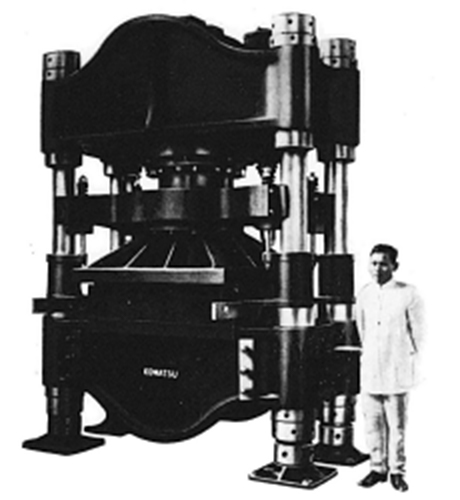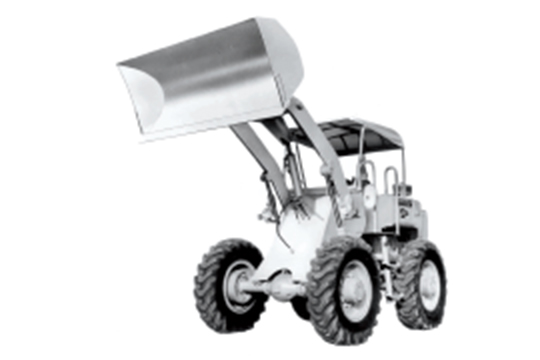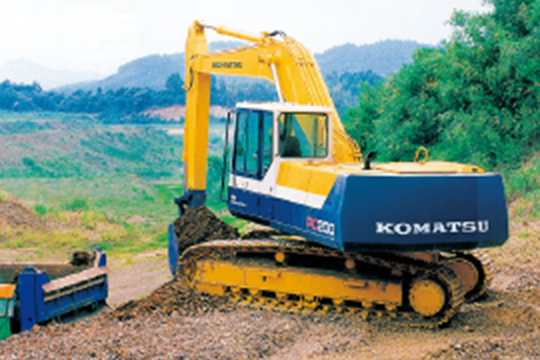2001. KOMTRAX as standard feature: Anticipating the coming age of IoT.
The Komatsu Machine Tracking System (KOMTRAX) allows for the remote checking of the location and operating conditions of Komatsu’s construction machines around the world via GPS and communication devices which are installed on the machines. The system is also useful for theft prevention and credit management. Starting with the PC200-7 in 2001, the system came with all models as standard. The data obtained from KOMTRAX is effectively used for the enhancement of customer service and for production planning.
2004 Demining machines: Contributing to peace by using bulldozer technologies.
For the removal of antipersonnel landmines buried across conflict areas in the world, Komatsu developed the D85MS-15 demining machine based on the D85 bulldozer. Equipped with protective armor, the demining machine crushes landmines buried up to 30 cm underground by using a special tool attached to the front part of the machine. Compared with manual removal, this machine has removed the mines 25 to 50 times faster. The first unit was shipped to Afghanistan, followed by other units to Cambodia and Angola, contributing to peace.
2008 Launched the world’s first* hybrid hydraulic excavators.
The world’s first* hybrid hydraulic excavator, “PC200-8,” was launched and equipped with the in-house developed Komatsu Hybrid System, achieving dynamic fuel economy. In 2010, full-scale mass production of the HB series started and in 2011 an award (for technology) from the Japan Society of Mechanical Engineers was received.
*Among the major seven products available on the market (surveyed by Komatsu)
2008 Succeeded in the world’s first commercial deployment* of the Autonomous Haulage System (AHS)
Komatsu led the world by deploying the AHS at a copper mine in Chile. By equipping dump trucks with a high-precision GPS, an obstacle detection sensor, and a variety of controllers for the central management of their operation in the main control room, Komatsu achieved 24-hour unmanned operation of the dump trucks. The AHS contributes to substantially increasing on-site productivity and safety and solving the issue of the labor shortage.
*Surveyed by Komatsu.
2013 ICT-intensive bulldozers: Creating innovation at construction sites.
Komatsu achieved the world’s first commercial deployment* of the “D61PXi/EXi” intelligent machine control (iMC) bulldozer, which features automatic blade controls from excavation to the final levelling of land. It was developed by fusing Komatsu’s control technology with Topcon’s GNSS survey technology. The bulldozer frees its operators from complex blade manipulation, thereby reducing their work burden, enabling even inexperienced operators to work just like skilled operators, and contributing to solving the issue of operator shortage at construction sites.
*Surveyed by Komatsu
2014 Achieved intelligent Machine Control with ICT hydraulic excavators.
Development of the PC200i/PC210LCi, the world’s first* hydraulic excavator equipped with the Machine Control system, boosted the automation of construction work. By collating the information about the location of the bucket blade obtained through the GNSS antenna and the base station with the design data, the system controls the operation of the work equipment. Starting in 2015, a mounted stereo camera on the machine enabled onboard surveying, which has led to the idea of “SMARTCONSTRUCTION.”
*Surveyed by Komatsu
2015“SMARTCONSTRUCTION”:Creating a workplace of the future.
“SMARTCONSTRUCTION” is a solution service to create safe, highly productive, smart and clean construction sites of the future by connecting all kinds of data available at construction sites through the use of ICT. By fusing the 3D terrain data obtained by using drones with ICT construction equipment, Komatsu has increased the efficiency of the process from surveying to inspection and has also “visualized” the process, thereby contributing to the solution of problems at construction sites.
2020 Launched PC30E-5 electric mini excavator in Japan
Komatsu launched the PC30E-5 electric mini excavator in Japan, an industry-pacesetting model, to promote the widespread use of construction equipment friendly to humans and the natural environment. Based on Komatsu’s accumulated technological expertise of hybrid construction equipment and electric forklift trucks, this electric model offers excavation performance on par with the internal combustion model of the same power output. While achieving zero exhaust gas and an outstanding noise reduction, it also promises extended use in indoor and night-time work.
2020 Launched“SMARTCONSTRUCTION Digital Transformation”
Komatsu launched four new IoT devices and eight new applications within its existing SMARTCONSTRUCTION offerings. These will accelerate digital transformation efforts, including SMARTCONSTRUCTION Retrofit kit ICT capabilities, such as 3D machine guidance and payload measurement, to conventional construction equipment. It also began the formal introduction of SMARTCONSTRUCTION in the United States and Europe (Germany, United Kingdom, France, and Denmark). While the previous version of SMARTCONSTRUCTION digitized only part of the construction process (“vertical digitization”), these new IoT devices and applications will allow for the digitization of the entire process (“horizontal digitization”). This will enable worksite operations to be optimized by synchronizing the actual worksite with its digital twin, thereby achieving dynamic improvement in the safety, productivity, and environmental performance of the entire construction.








.jpg)
